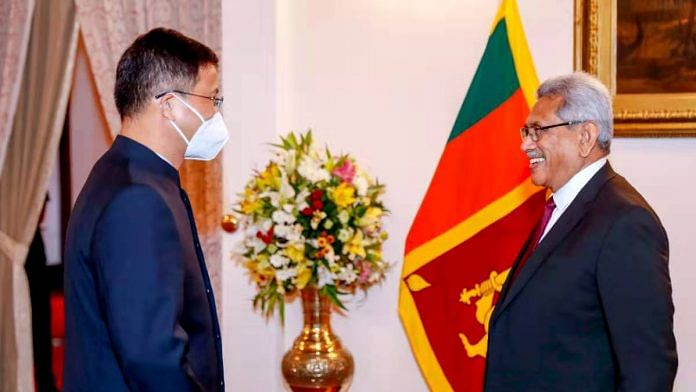New Delhi: The exit of Sri Lanka’s China-friendly president, Gotabaya Rajapaksa, could be a critical blow to ties between the island nation and its single-largest foreign investor, experts have told ThePrint. China offered no immediate official comment following President Rajapaksa’s flight overseas early Wednesday.
Following the storming of the Presidential Palace by protestors Sunday in Colombo, China’s Ministry of Foreign Affairs stated that it hoped Sri Lanka would “overcome the current difficulties and strive to restore stability, revitalise the economy and improve people’s livelihoods at an early date”.
“For China, the investments and funding of projects in Sri Lanka are primarily financial decisions. They want to ensure a return on investment. When there is a question mark over this, China limits engagement and holds back”, said Deep Pal, visiting scholar at Carnegie Endowment for International Peace, to ThePrint.
Over the past decade and a half, China has invested billions of dollars into Sri Lanka. According to data from the British think-tank Chatham House, China invested $12.1 billion between 2006 and 2019 in Sri Lanka. Specifically, since 2013, China has incrementally increased its presence and influence in Sri Lanka through the Belt and Road Initiative (BRI).
While China’s engagements with Sri Lanka precede the BRI, it has acted as a catalyst for their presence in the country. The marquee project has been the now debt-ridden Hambantota Port Project, which China now has on lease from Sri Lanka for 99 years.
In 2020, according to the Central Bank of Sri Lanka, China’s loans to Sri Lanka totaled $4.6 billion. However, China only accounts for 10 per cent of Sri Lanka’s external debt.
In June, Rajapaksa had told Bloomberg that he felt China had shifted its “strategic focus” to Southeast Asia and Africa, moving away from economically troubled countries like Sri Lanka in South Asia.
“China’s silence has also been due to the public sentiment towards the Rajapaksas,” said Professor Harsh V. Pant, Vice-President of Studies and Foreign Policy at the Observer Research Foundation.
Also read: Sri Lanka walks a tightrope — Chinese ‘credit card’ on one side, Indian friendship on other
‘China’s silence also due to public sentiment towards Rajapaksas’
Speaking after Mahinda Rajapaksa resigned as Prime Minister of Sri Lanka in May, and despite close links to the Rajapaksas, the Chinese Foreign Ministry spokesperson decided to dodge questions on his resignation.
Spokesperson Zhao Lijian said, “We have noted the latest developments in Sri Lanka and are closely following the situation.”
Speaking to ThePrint, Prof Pant said: “China aims to de-hyphenate its identity in Sri Lanka from the Rajapaksas, given they were their main access point into the country. Since China wants to return to doing business later in the country, it was essential for them to stop being associated with them.”
In June, Sri Lanka was unable to access a $1.5 billion credit line from Beijing and also hadn’t heard back from China about a $1 billion loan to buy essential commodities.
“It is essential to recall, prior to the crisis, China also did not respond positively to Sri Lanka’s requests for debt-restructuring”, added Prof. Pant.
Also read: Energy, infra, communication — India has big plans to help Sri Lanka & deepen relationship
$76 million in aid from China, India filling vacuum
China’s approach to the crisis and consequent aid packages to bail out the island nation is in stark contrast to India. While China has sent emergency grants worth $76 million, India has already provided aid worth $3.5 billion to Colombo. India’s aid supplies to the resource-strapped nation have included rice, kerosene and milk powder, along with 25 tons of drugs and medical supplies.
“India has tried to fill the vacuum left behind by China and has provided essential relief to the country. There have been very high-profile acknowledgements in Sri Lanka of India’s assistance. This could bode well for India in the country in the future”, Prof. Pant said.
Time will tell if China’s silence is strategic
However, India’s realities vis-à-vis Sri Lanka are significantly different to those of China, and these have manifested themselves in their response to the current situation.
“India is tied by geographical proximity to Sri Lanka. Political and social factors also magnify its involvement in Sri Lanka, as can be seen in the current crisis”, explained Deep Pal
China knows that being passive currently does not mean that they will not have access into Colombo in the future, added Pal, as he explained the fine print of China’s cautious response.
“However, whether this ambivalence, silence, or passiveness from Beijing is strategic or not, time will tell”, remarks Professor Pant.
(Edited by Zinnia Ray Chaudhuri)
Also read: The role China played in pushing Sri Lanka into a debt trap & what India can do to help



